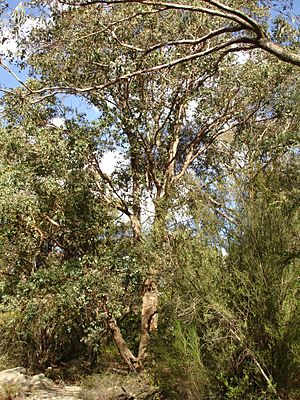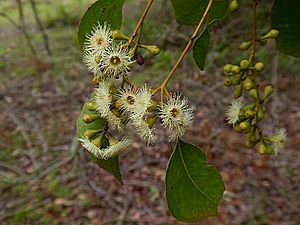Round-leaved box facts for kids
Quick facts for kids Round-leaved box |
|
|---|---|
 |
|
| Eucalyptus baueriana in Maranoa Gardens, Melbourne | |
| Scientific classification | |
| Genus: |
Eucalyptus
|
| Species: |
baueriana
|
 |
|
| E. baueriana, field distribution | |
The Eucalyptus baueriana, often called blue box or round-leaved box, is a special tree that only grows in south-eastern Australia. It has bark that feels rough, like fibers or flakes, on its trunk and branches. Its adult leaves look like eggs, and its flower buds are shaped like ovals or diamonds, growing in groups of seven. When it blooms, it has white flowers, and its fruit looks like a small cone.
Contents
What Does the Round-leaved Box Look Like?
The Round-leaved Box is a tree that usually grows to about 20 meters (66 feet) tall. Sometimes, it can be a smaller tree or a mallee (a type of eucalyptus that grows many stems from the ground) up to 12 meters (39 feet) high. This tree has a special woody swelling at its base called a lignotuber, which helps it regrow after fires.
Its bark is light grey and stays on the tree, feeling fibrous or flaky. It often has whitish patches. The bark on the higher branches is smooth and grey, and it peels off in short ribbons.
Leaves of the Round-leaved Box
- Young plants and new shoots have broad, egg-shaped to almost round leaves. These leaves are about 35–60 millimeters (1.4–2.4 inches) long and 39–80 millimeters (1.5–3.1 inches) wide.
- Older trees often still have these younger-looking leaves mixed in with their mature leaves.
- Adult leaves are egg-shaped, about 53–105 millimeters (2.1–4.1 inches) long and 23–52 millimeters (0.91–2.05 inches) wide. They grow on a stem called a petiole, which is 18–43 millimeters (0.71–1.69 inches) long.
- Both sides of the leaves are the same dull or shiny green color. Sometimes, they might even have a slightly whitish, powdery look.
Flowers and Fruit of the Round-leaved Box
- The flowers grow in groups of seven. They appear in the leaf axils (the spot where a leaf meets the stem) on a stem called a peduncle, which is 5–11 millimeters (0.20–0.43 inches) long.
- Each flower bud has its own small stem, called a pedicel, about 1–5 millimeters (0.039–0.197 inches) long.
- When the buds are ready to open, they are oval to diamond-shaped, about 3–6 millimeters (0.12–0.24 inches) long and 3–4 millimeters (0.12–0.16 inches) wide. They have a cone-shaped cap called an operculum.
- The tree mainly flowers from September to December, and its flowers are white.
- After flowering, the tree produces a woody, cone-shaped fruit called a capsule. These fruits are 4–7 millimeters (0.16–0.28 inches) long and 4–7 millimeters (0.16–0.28 inches) wide. The parts that open to release seeds (called valves) are tucked inside the fruit.
It's important to know that the Round-leaved Box is different from other similar trees. For example, it has shinier mature leaves than the more common Eucalyptus polyanthemos. It also differs from the Northern blue box (Eucalyptus magnificata), which has smoother, bluish-green leaves and bigger, often waxy-looking buds and fruits.
How the Round-leaved Box Got Its Name
The Eucalyptus baueriana was first officially described in 1843 by a scientist named Johannes Conrad Schauer. He published his description in a book called Repertorium Botanices Systematicae. The second part of its scientific name, baueriana, was chosen to honor Ferdinand Bauer, who was a famous plant artist.
In 2011, another scientist, Kevin James Rule, identified three different types, or subspecies, of E. baueriana:
- E. baueriana subsp. baueriana: This is the main type, a tree that grows up to 20 meters (66 feet) tall. Its fruit is about 6–7 millimeters (0.24–0.28 inches) long and 4–6 millimeters (0.16–0.24 inches) wide.
- E. baueriana subsp. deddickensis: This is a smaller tree or mallee, reaching up to 12 meters (39 feet) tall. Its fruit is smaller, about 3–5 millimeters (0.12–0.20 inches) long and 3–5 millimeters (0.12–0.20 inches) wide. Its leaves are about 50–70 millimeters (2.0–2.8 inches) long and 40–60 millimeters (1.6–2.4 inches) wide.
- E. baueriana subsp. thalassina, also known as the Werribee blue box: This is also a small tree or mallee, growing up to 12 meters (39 feet) tall. Its fruit is similar in size to subsp. deddickensis (3–5 millimeters long and wide). However, its leaves are smaller, about 30–50 millimeters (1.2–2.0 inches) long and 20–40 millimeters (0.79–1.57 inches) wide.
Where Does the Round-leaved Box Grow?
The blue box tree grows in woodlands close to the coast in south-eastern Australia. You can find it in New South Wales, starting from Putty in the north and going south to areas near Melbourne in Victoria. Some reports also suggest it might grow near Stanthorpe in Queensland and in the Glen Innes - Armidale area of New South Wales.
The subspecies deddickensis is only found in two separate groups of trees along the Deddick River in the far north-eastern part of Victoria. The subspecies thalassina is found near the Werribee River in the Bacchus Marsh area.
See also
 In Spanish: Boj de hojas redondas para niños
In Spanish: Boj de hojas redondas para niños


